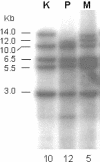DNA polymorphism assay distinguishes isolates of Leishmania donovani that cause kala-azar from those that cause post-kala-azar dermal Leishmaniasis in humans
- PMID: 15071036
- PMCID: PMC387559
- DOI: 10.1128/JCM.42.4.1739-1741.2004
DNA polymorphism assay distinguishes isolates of Leishmania donovani that cause kala-azar from those that cause post-kala-azar dermal Leishmaniasis in humans
Abstract
Leishmania donovani in India causes visceral infection (kala-azar) and dermal infection (post-kala-azar dermal leishmaniasis). We report here the identification of polymorphism in a well-defined genetic locus among the Leishmania parasites causing the visceral and dermal manifestations, in a comparison of 15 post-kala-azar dermal leishmaniasis and 12 kala-azar patient isolates.
Figures

References
-
- Das Gupta, S., D. K. Ghosh, and H. K. Majumder. 1991. A cloned kinetoplast DNA mini-circle fragment from a Leishmania spp. specific for post-kala-azar dermal leishmaniasis strains. Parasitology 102:187-191. - PubMed
-
- Desjeux, P. 2001. The increase in risk factors for leishmaniasis worldwide. Trans. R. Soc. Trop. Med. Hyg. 95:239-243. - PubMed
-
- El Tai, N. O., M. E. Fari, I. Mauricio, M. A. Miles, L. Oskam, S. H. El Safi, W. H. Presber, and G. Schonian. 2001. Leishmania donovani: intraspecific polymorphisms of Sudanese isolates revealed by PCR-based analyses and DNA sequencing. Exp. Parasitol. 97:35-44. - PubMed
-
- Guerbouj, S., K. Victoir, I. Guizani, N. Seridi, S. N. Nuwayri, M. Belkaid, R. B. Ismail, D. Le Ray, and J. C. Dujardin. 2001. Gp63 gene polymorphism and population structure of Leishmania donovani complex: influence of the host selection? Parasitology 122:25-35. - PubMed
-
- Jaffe, C. L., E. Bennett, G. Grimaldi, Jr., and D. McMahon Pratt. 1984. Production and characterization of species specific monoclonal antibodies against Leishmania donovani for immunodiagnosis. J. Immunol. 133:440-447. - PubMed
MeSH terms
Substances
LinkOut - more resources
Full Text Sources

